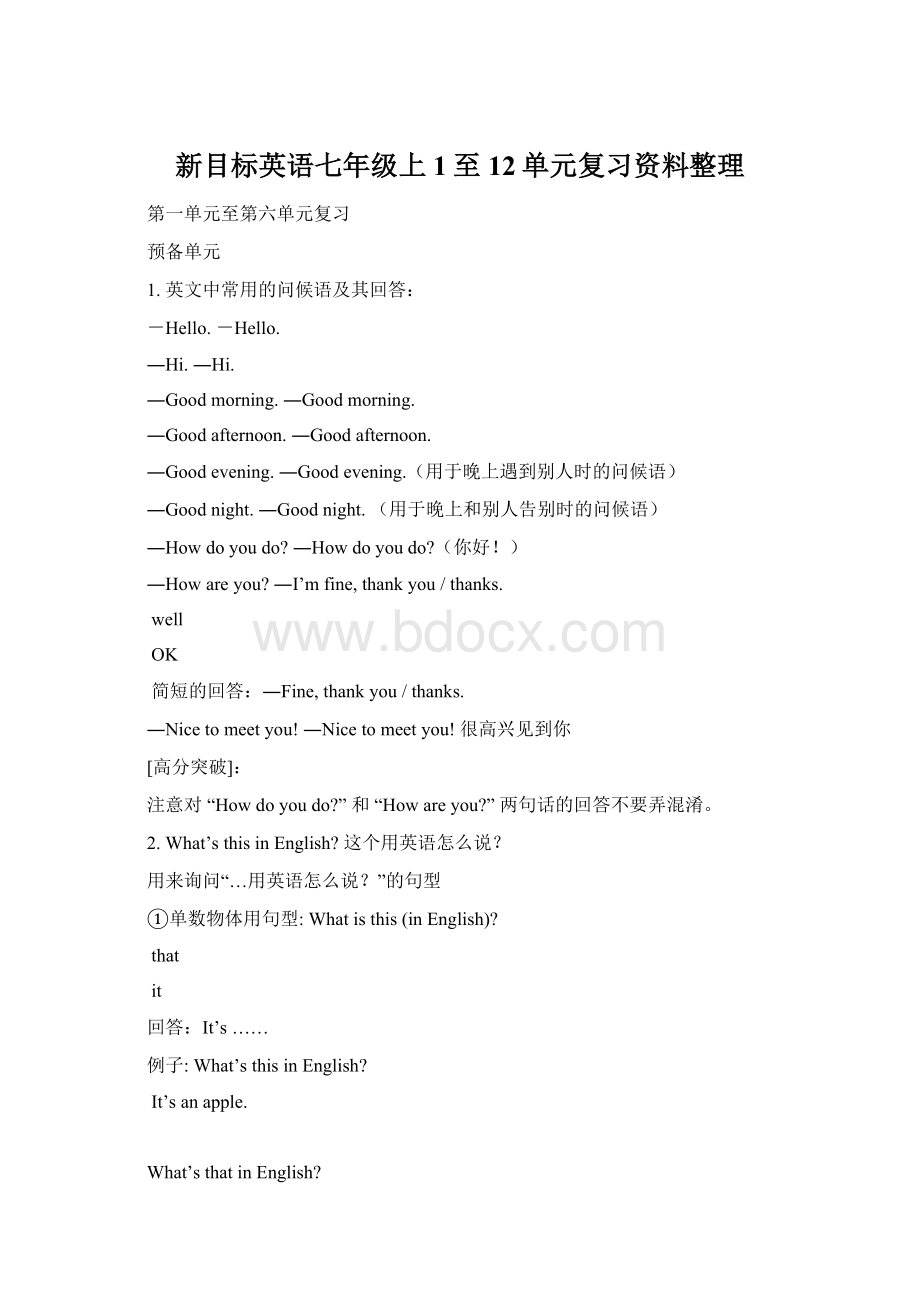新目标英语七年级上1至12单元复习资料整理.docx
《新目标英语七年级上1至12单元复习资料整理.docx》由会员分享,可在线阅读,更多相关《新目标英语七年级上1至12单元复习资料整理.docx(22页珍藏版)》请在冰豆网上搜索。

新目标英语七年级上1至12单元复习资料整理
第一单元至第六单元复习
预备单元
1.英文中常用的问候语及其回答:
-Hello.-Hello.
―Hi.―Hi.
―Goodmorning.―Goodmorning.
―Goodafternoon.―Goodafternoon.
―Goodevening.―Goodevening.(用于晚上遇到别人时的问候语)
―Goodnight.―Goodnight.(用于晚上和别人告别时的问候语)
―Howdoyoudo?
―Howdoyoudo?
(你好!
)
―Howareyou?
―I’mfine,thankyou/thanks.
well
OK
简短的回答:
―Fine,thankyou/thanks.
―Nicetomeetyou!
―Nicetomeetyou!
很高兴见到你
[高分突破]:
注意对“Howdoyoudo?
”和“Howareyou?
”两句话的回答不要弄混淆。
2.What’sthisinEnglish?
这个用英语怎么说?
用来询问“…用英语怎么说?
”的句型
①单数物体用句型:
Whatisthis(inEnglish)?
that
it
回答:
It’s……
例子:
What’sthisinEnglish?
It’sanapple.
What’sthatinEnglish?
It’sapen.
What’sitinEnglish?
It’sapencilsharpener.
②用来询问复数物体的句型:
Whatarethese(inEnglish)?
those
they
回答:
They’re……
例子:
WhataretheseinEnglish?
They’reapples.
用什么语言,介词用in:
“in+language”.例如:
inEnglish用英语
inChinese用汉语
inJapanese用日语
inyourownwords用自己的语言
3.WhatcoloristhisZ?
这个字目Z是什么颜色?
1)对颜色提问的两种方法:
Whatcolor+系动词+具体的物体=What’sthecolorof+具体的物体?
例如:
Whatcolorisyourbackpack?
=What’sthecolorofyourbackpack?
2)colorv.着色
colorsth.+颜色,例如:
Iwanttocoloritred.
[高分突破]:
1)对名词(复数)的颜色提问时,不能用whatcolors,例如:
Whatcolorarethesehats?
(√)
Whatcolorsarethesecups?
(×)
2)color是可数名词,例如:
Idon’tlikethesecolors.
Unit1:
Myname’sGina
1)对姓名的几种提问及回答:
What’syour/his/hername?
回答:
My/His/Hernameis…=I’m…;Sheis…;Heis…
What’syourname?
MynameisSandra.或者说.I’mSandra.
What’shisname?
HisnameisTom.或者说.HeisTom.
What’shername?
HernameisAnna.或者说.SheisAnna.
2)姓氏:
familyname/lastname
名:
givenname/firstname
全名:
fullname
Eg.MyfullnameisAlanSmith.MyfistnameisAlan,mylastnameisSmith.
3)中文名字的习惯:
familyname/lastname+givenname/firstname
例如:
LuGuoyu
familyname/lastname:
Lugivenname/firstname:
Guoyu
英文名字的习惯:
givenname/firstname+familyname/lastname
例如:
SandraSmith
[高分突破]:
在交际英语中应注意由于中英文名字的区别所造成的对人物的称呼也不同,例如:
ZhangXiaoli:
MissZhang/Xiaoli(√)
Zhang/MissXiaoli(×)
DaveGreen:
Mr.Green/Dave(√)
Green/Mr.Dave(×)
Unit2:
Isthisyourpencil?
1.这个单元的重点句型:
①Isthis/that+单数名词?
Yes,itis./No,itisn’t.(√)
Yes,this/thatis./No,this/thatisn’t.(×)(回答时:
我们要用it来代替问句里边的this和that)
例如:
Isthatyourbrother’sbackpack?
Yes,itis.
Arethese/those+复数名词?
Yes,theyare./No,theyaren’t.
[高分突破]:
-Isthis/that+人?
-Yes,itis./No,itisn’t.(√)
-Yes,he/sheis./No,he/sheisn’t.(×)
但若是:
-Isthis/that+可以区分性别的词+人?
我们在回答是就要用表示人的人称代词(she,he,they)
Isthisboyyourbrother?
Yes,heis./No,heisn’t.
Isthatwomanyourmother?
Yes,sheis./No,sheisn’t.
Arethese/those+复数名词
Yes,theyare./No,theyaren’t.
(注意:
此时不管these和those后是否有可以区分性别的词,回答是统统一样,因为复数的的代词都是一个,就是they.)
②Howdoyouspellit(或者是具体的物体)?
回答时我们得把这个单词拼写出来,并且要大写。
Eg.---Howdoyouspell“watch”
---W-A-T-C-H
③Hereismyfamilyphoto.这是我的全家福照片。
它等于句型:
Thisismyfamilyphoto.
1)Hereismyfamilyphoto是倒装句式
倒装句结构
①副词+谓语+主语(名词)
Eg.Hereisyourletter.
②副词+主语(代词)+谓语
Hereyouare.
2)Thisis....的句型也表示“这是……。
”但通常用于介绍;而“Hereis....”常用于把某物给说话的对象。
在第三单元中这两句是同义句。
2.这个单元的重点短语
①Sorry和excuse的用法
sorry“对不起”用于引出某一过错。
Excuseme.“对不起”用于引起对方的注意。
例如:
I’msorry。
Idon’tknow.
Excuseme,isthisyourbackpack?
②CallTinaat495-3539.打495-3539找蒂娜。
callv.打电话
1)单独使用 “打电话”,例如:
Pleasecallthisevening.
2)call+sb. “给某人打电话”,例如:
PleasecallBobthisevening.
3)call+telephonenumber “拨打某一电话号码”,例如:
Pleasecall2377485now.
4)call+sb.+at+telephonenumber “打某电话找某人”,例如:
Pleasecallmyteacherat65774839.
请打2684753这个电话找我的老师.
PleasecallGina,herphonenumberis2684753.
=PleasecallGinaat2684753.
Unit3:
Thisismysister
1.介绍人的句型
①
Thisis
+单数名词。
Thatis
Eg.Thisismysister.
Thatishermother.
②
These
+are+复数名词
Those
Eg.TheseareDave’sparents.
Thosearehisuncleandaunt.
③系动词+人名/人称代词+其他?
回答:
相应的人称代词+相应的系动词
Eg.IsGuoPengyourbrother?
Yes,heis./No,heisn’t.
Isthisyourfather?
Yes,itis./No,itisn’t.
2.重点短语
名词
①thanksfor+“为……而感谢你。
”
动词ing
Eg.Thanksforyourhelp.谢谢你的帮助。
Thanksforhelpingme.谢谢你帮我。
1)感谢你。
Thanks.=Thankyou.(√)
Thank.(×)
Thanksyou.(×)
2)全家福的表示方法
thephotoofyourfamily=yourfamilyphoto你的全家福
thephotoofhisfamily=hisfamilyphoto他的全家福
thephotoofherfamily=herfamilyphoto她的全家福
②takesth.tosb./地点
Eg.Pleasetakethesethingstoyourbrother.请把这些东西带给你弟弟。
take,bring的区别:
take“带走”,从近处带到远处,例如:
Pleasetakethesebookstoyourhomeafterschool.
bring“带来”,从远处带来,通常也是用”bringsth.tosb./地点”例如:
PleasebringsomeCDstome.
Unit4:
Where’smybackpack?
1.重点句型:
①Where+系动词+人/物?
“。
。
。
。
。
。
在哪里?
”
回答:
某人/某物/人称代词+系动词+地点(表示方位的介宾短语)
注意:
回答时通常用的是人称代词
Eg.Where’smybackpack?
It’sunderthedesk。
Whereismymother,dad?
(爸,我妈在哪里?
)
Sheisinthebedroom.(她在卧室里。
)
②Idon’tknow.我不知道。
(这是一个对含有实意动词的否定句),它的肯定句是:
Iknow.我知道。
注意:
含有实意动词的陈述句变否定句规则:
在实意动词前加上助动词的否定形式don’t或者doesn’t(在主语是第三人称单数时加doesn’t.)
将下列句子变为否定句:
Eg.Ilikeapples→
Marylikesicecream.→
Johneatseggsforhisbreakfast.→
WillamandTinagotoschoolbybikeeveryday.
关于含有实意动词的陈述句变为一般疑问句请参照笔记内容。
将下列句子变为一般疑问句:
Eg.Ilikeapples→
Marylikesicecream.→
Johneatseggsforhisbreakfast.→
WillamandTinagotoschoolbybikeeveryday.
③Ineedmyhat,myIDcard,mynotebookandmypencils.我需要我的帽子,身份证,笔记本和铅笔。
needv.需要
1)need+sth./sb.“需要……”例如:
Sheneedsanotebook.
Ineedyounow.
2)needtodosth.“需要做……”例如:
Ineedtolistentosomerelaxingmusic.
③.Therearemanybooksinthebookcase.书柜里有许多书。
Therebe句型
1)构成及意义
Therebe+名词+地点.“在某处有什么;在某地有某物”
例如:
Thereisanalarmclockonthedresser.
某物某地
Therearesomekeysinthedrawer.
某物某地
2)否定式
在系动词后加not就可以,和一般的含有系动词的陈述句变否定句是一样的。
Thereisnotanalarmclockonthedresser.
1)疑问句及回答
和一般的含有系动词的陈述句变一般疑问句是一样的。
Isthereanalarmclockonthedresser?
--Yes,thereis.
--No,thereisn’t.
Arethereanypensinyourpencilcase?
--Yes,thereare.
--No,therearen’t.
[高分突破]:
Therebe句型的就近原则:
若有两个或两个以上的主语是,谓语常与靠近它的那个主语一致。
例如:
Thereisabook,twopensandsomecupsonthetable.
Therearetwopens,somecupsandabookonthetable.
there与have的区别在于:
have表示某人或某物拥有什么;而Therebe表示在什么地方存在什么。
2.重点短语
表示方位的介词:
on“在…上”;
in“在…里面”;
under“在…下面”;
between+两个物体“在…之间”;
betweenAandB“在A和B中间”;
near“在…附近”;
at“在…旁边”;
behind“在…后面”
eg.---Where’smyhat?
---It’sonthebed.
---Where’sAnna’smathbook?
---It’sinherbackpack.
---Wherearemykeys?
---They’reunderthechair.
---Whereismybasketball?
---It’sbetweenthetwodesks.
---Whereismyplant?
---It’sbetweenthecomputerandmydictionary.
---Where’sTom?
---Heisnearthedoor.
---Where’sLucy?
---Sheisatthetable.
---Where’sthecat?
---It’sbehindyou.
Unit5:
Doyouhaveasoccerball?
1.重点句型
①
第一人称(I,we)
Do+第二人称(you)+动词原形+其他部分?
复数名词或代词
回答:
Yes,相应的人称代词+do.
No,相应的人称代词+don’t.
Eg.Doyouhaveaping-pongball?
Yes,Ido./No,Idon’t.
DoIhaveabaseball?
Yes,Ido./No,Idon’t.
Dowehaveasoccerball?
Yes,wedo./No,wedon’t.
②
第三人称代词(she,he,it)
Do++动词原形+其他部分?
单数名词
回答:
Yes,相应的人称代词+does.
No,相应的人称代词+doesn’t.
DoesLilyhaveatennisracket?
No,shedoes./No,shedoesn’t.
Doesheeatbroccoli?
No,hedoes./No,hedoesn’t.
③
Thatsoundsgood.那听起来不错。
sound是个半系动词,它后面要用形容词。
像它这样的词还有:
look(看起来),smell(闻起来),feel(感觉起来),taste(尝起来)。
(大家注意这一类是感官动词)
2.重点短语
①Let’splaybasketball.让我们打篮球。
1)let’s=letus让我们
2)letsb.dosth.让某人做某事例如:
Letmeplaytheguitar.
LetTonybuyapictureforyou.
[高分突破]:
A.letsb.dosth.中的sb.若是代词要用宾格形式。
Letsheanswermyquestion.(×)
Letheranswermyquestion.(√)
B.letsb.dost..中的sb.即使是第三人称单数后面的动词仍用原形,例如:
Lethimplayssoccer.(×)
Lethimplaysoccer.(√)
.
名词修饰名词:
一般情况下变复数时,只有被修饰的名词变为复数形式,例如:
appletree-appletreespencilcase-pencilcases
如果修饰词为man,woman则两个名词都要变为复数形式,例如:
womandoctor-womendoctorsmanteacher-menteachers
有的词本身就是复数:
people
②HeonlywatchesthemonTV.他只在电视上观看它们。
辨析”看”:
watch,see,look,read
look是强调看的动作。
例:
look!
itisabird.
see是强调看的结果,强调的看得见看不见。
例:
Icanseeabird.
watch用在看电视看比赛的时候。
例:
Let'swatchTVtogether.
Unit6:
Doyoulikebananas?
你喜欢香蕉吗?
1.句型:
句型同第五单元
2.重点短语
①likev.喜欢
反义词:
dislike不喜欢
likesth./sb.喜欢…
likedoingsth.喜欢做…
liketodosth.想做…
[高分突破]
likedoingsth.喜欢做…(长期的喜好,习惯)
liketodosth.想做…(短期的,具体的某一次活动)=wanttodo
Eg.Ilikeeatingapples.
Iliketoeattoapples.
②Runnereatswell.跑步选手吃得好。
构词法:
在动词后面加-er或-or,将动词变为名词,意思是“做……的人”
直接加er:
clean–cleanersing-singerwait-waiterwork-workerteach-teacher
只加-r:
dance-dancerwrite-writerdrive-driver
双写尾字母:
run-runner
③RunningstarSandraClarkeatslotsofhealthyfood.跑步明星桑德拉克拉克吃许多健康的食物。
④alotof=lotsof可以用来修饰可数名词和不可数名词。
Jimeatsalotof/lotsofbroccoliforlunch.
Ihavealotof/lotsofbooks.
alot作状语,表示程度、数量或频率。
Ilikeice-creamalot.(这里相当于verymuch)
Thanksalot.(这里相当于verymuch)
⑤Forbreakfast,shelikeseggs,bananasandapples.
早饭她喜欢吃鸡蛋,香蕉和苹果。
1)for就……而言;对于……来说
eg.Forbreakfast,Jimlikeeggsandbroccoli.
2)have+三餐表示“吃早/中/晚饭”。
一般情况下我们不用eat和三餐搭配。
例如:
Iusuallyhavelunchathome.而很少说Iusuallyeatlunchathome.
Unit7Howmucharethesepants?
一、句型
①Howmuch+is+单数名词/代词?
“。
。
。
多少钱?
”
回答:
It’s+金钱的数目
注意:
本单元主要讲解了美国的货币dollar和中国的货币yuan。
要注意的是dollar有单复数之分,而yuan没有单复数之分,它只能用单数
Howmuchistheredsweater?
It’seightdollars.($8)
yuan(¥8)
②Howmuch+are+复数名词?
“。
。
。
多少钱?
”
回答:
They’re+金钱数目。
Howmucharethesepants?
They’retendollars.($10)
③CanIhelpyou?
“我能帮助你吗?
”“你要点什么?
”,用作商店用语,商场服务用语,也用于主动向对方提出帮助,相当于“WhatcanIdoforyou?
”
回答:
Yes,please